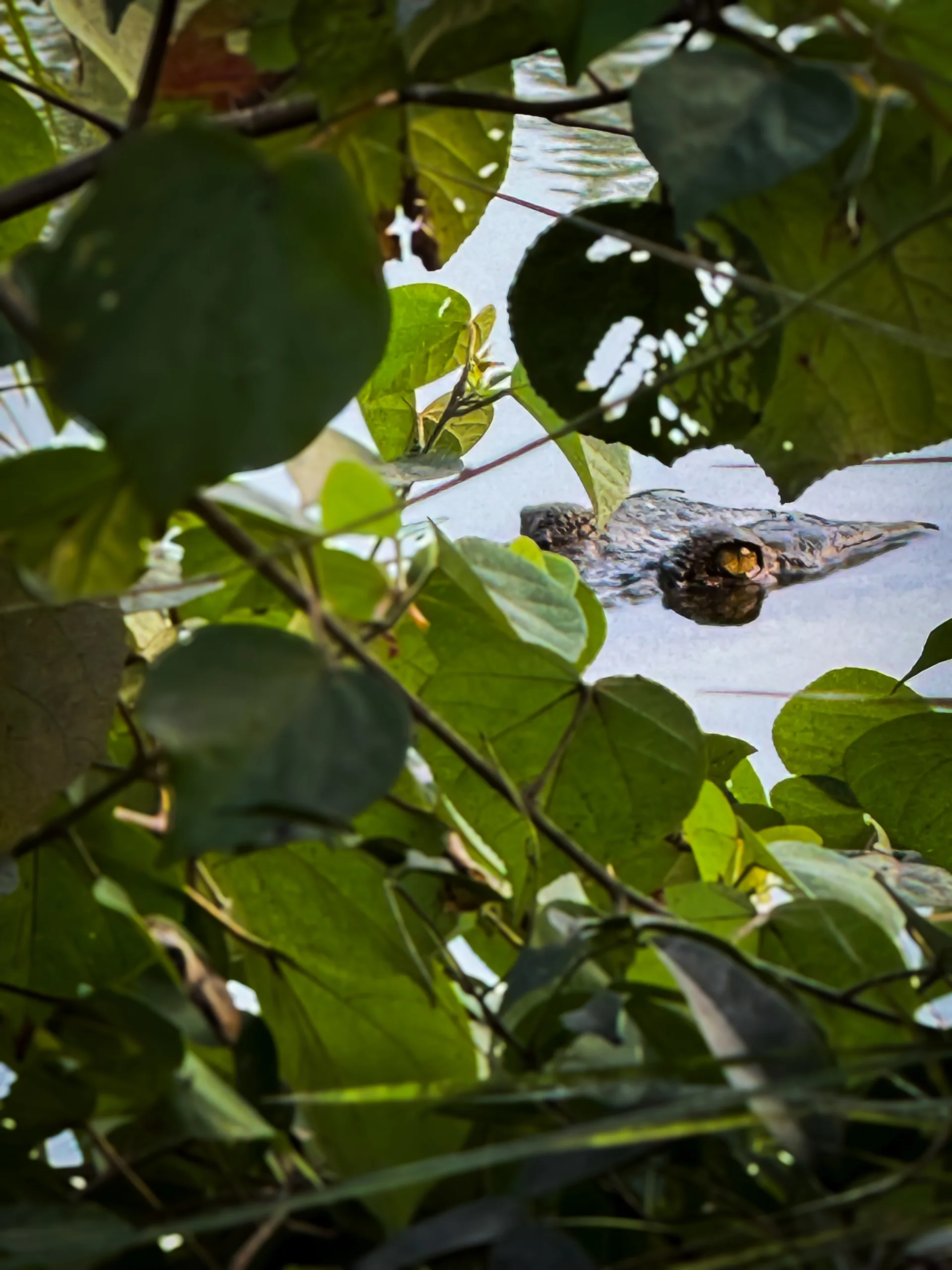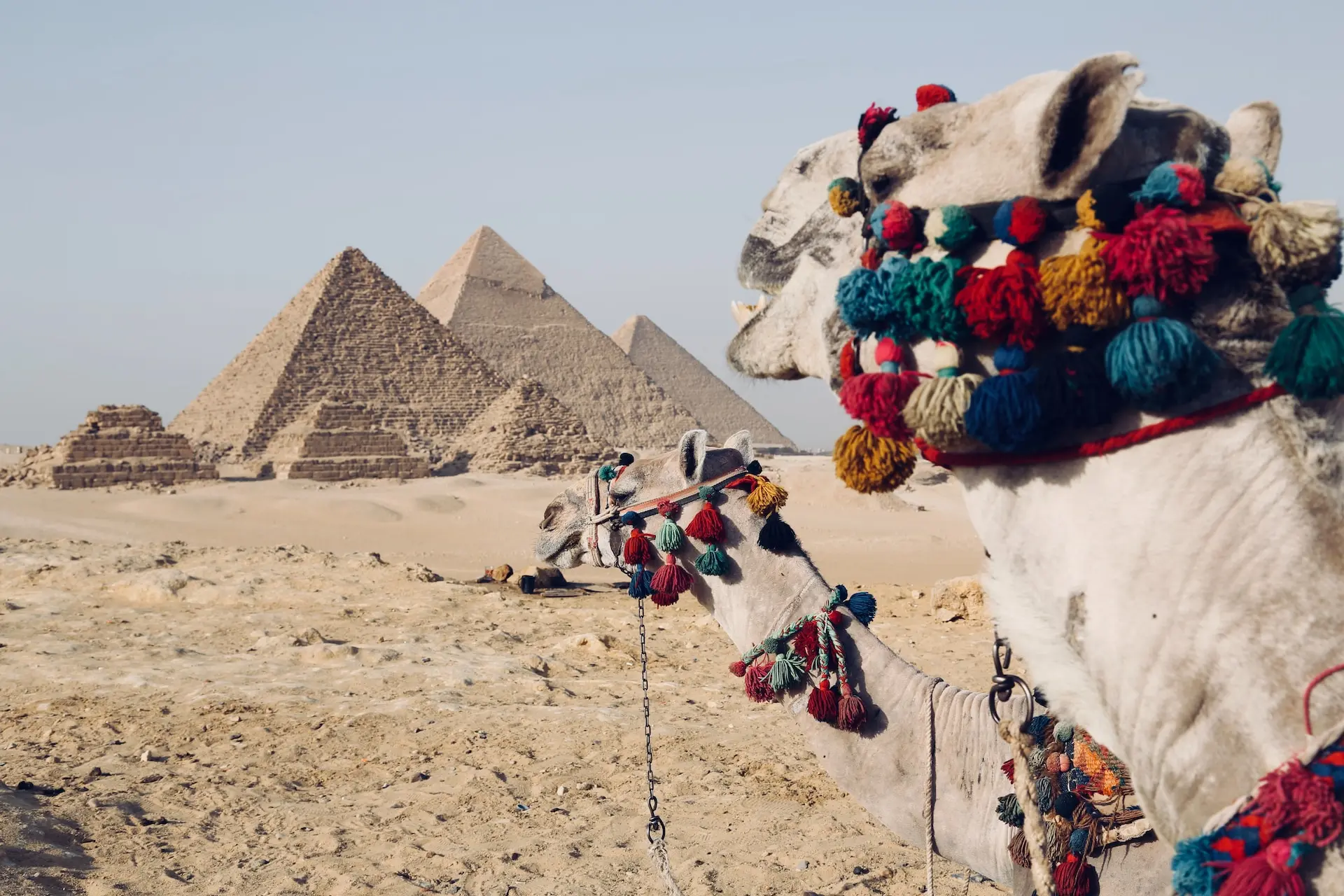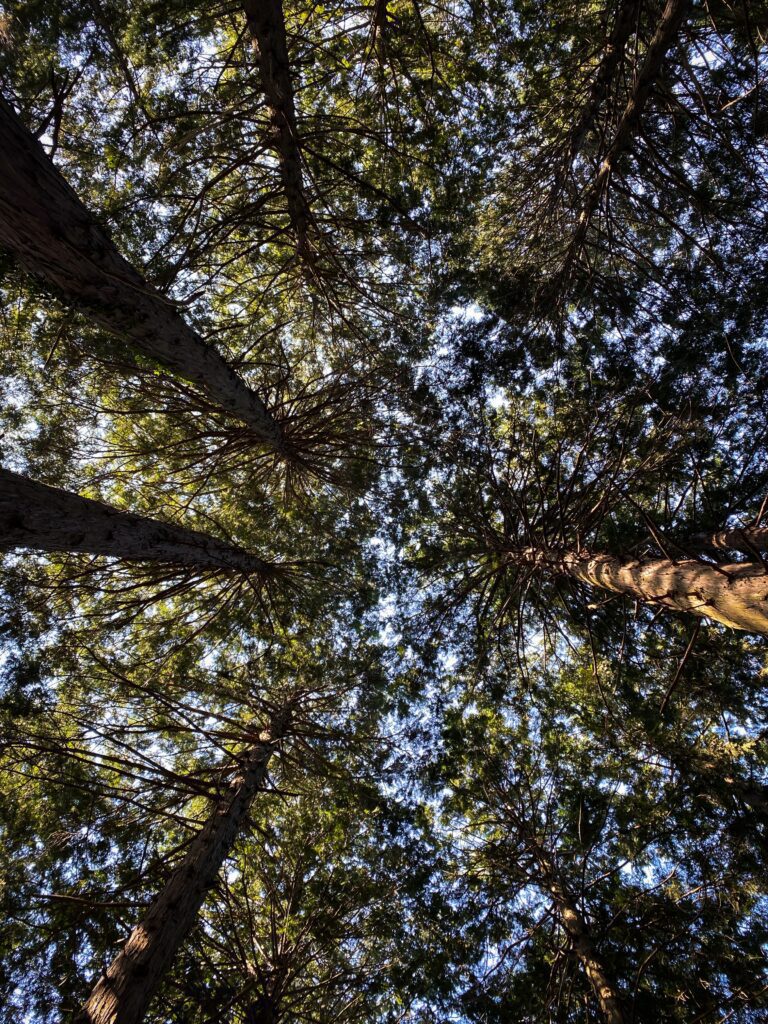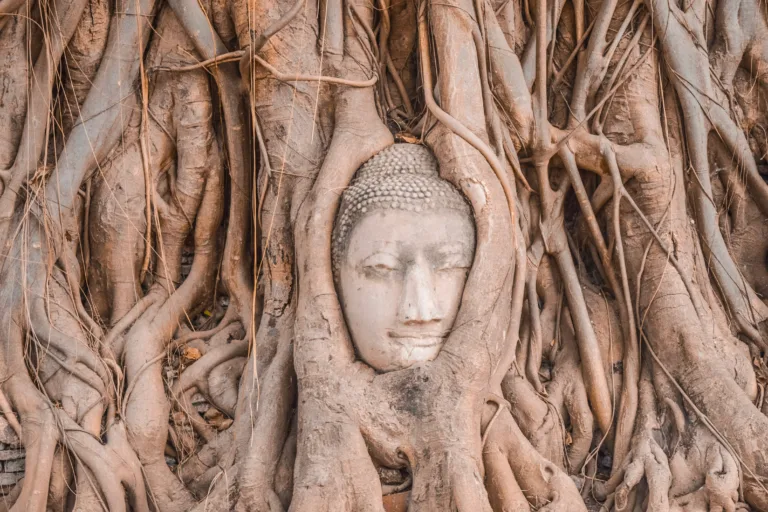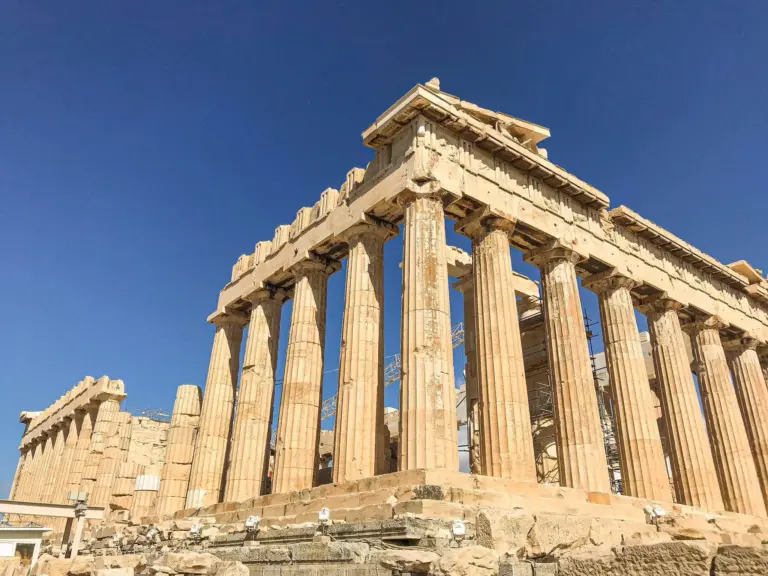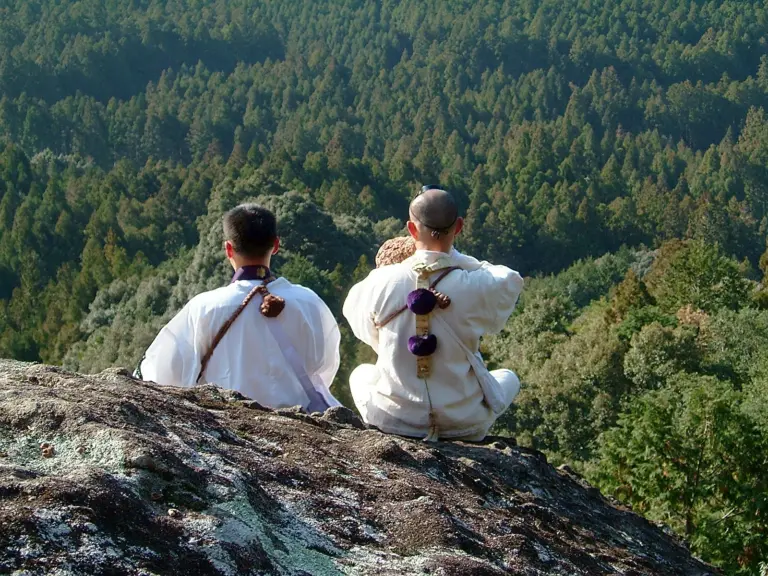Singapore is a small island city-state located in Southeast Asia and right next to Malaysia. It’s a melting pot of cultures and traditions, known as the City in a Garden, with a vibrant and modern metropolis with a rich history and diverse population. Despite its small size, Singapore packs a punch with its impressive skyline, world-class attractions, and mouth-watering cuisine!
Beyond its towering skyscrapers and state-of-the-art infrastructure lies a city with a fascinating past and unique fusion of cultures. As a food lover’s paradise, it offers a diverse range of cuisines influenced by numerous cultures and as a spiritual destination with its temples, mosques, and churches just a stone’s throw away from each other, it’s a chance to experience surreal cultural contrasts. With its perfect blend of modernity and tradition, Singapore is truly a country like no other!
Table of Contents
ToggleSingaporean Culture Overview
Again and again, you’ll hear that Singapore is a melting pot of cultures because it’s really true! With a diverse mix of Chinese, Malay, Indian and Western influences, you have a recipe for a truly unique blend. You can see this amazing fusion across all aspects of Singaporean culture such as its cuisine, traditions, and architecture. Speaking of, you might notice the stark contrast of traditional and modern, with colonial-era buildings standing alongside post-modern skyscrapers as you walk around the metropolis.
Having such a diverse population translates to having plenty of unique dishes to test your palettes on, not to mention the different festivals that are celebrated from the various communities such as Chinese New Year or Diwali! If you want to learn more about Singaporean culture, I’ve created a more in-depth article here.
Best Places to Visit in Singapore

1. Merlion Park
The Merlion in one of the most iconic symbols of Singapore! This half-lion, half-fish sculpture is a symbol of the country, representing its origins as a fishing village and its transformation into a modern metropolis. Located in the heart of the city, Merlion Park offers stunning views of the Marina Bay skyline, with the statue as the centerpiece. It stands at an impressive 8.6 meters (28 feet) and weighs 70 tons. It’s really fun to walk around this area as the atmosphere is very lively, even more so at night!
Cost: Free
2. Gardens by the Bay
Gardens by the Bay is a must-visit destination for anyone traveling to Singapore. This futuristic garden complex spans over 100 hectares and is a true marvel of engineering and design. There are actually numerous sites of interest within this city oasis. The most popular one being the Supertree Grove which is slowly being recognized as another one of Singapore’s symbols. There are also two massive nature conservatories, the Flower Dome and the Cloud Forest as well as a host of other attractions, such as the Heritage Gardens, World of Plants, and the Sun Pavilion. You can also take a stroll along a suspended walkway that offers stunning views of the Supertrees and the Singapore skyline.
If you need the Singapore City All-Inclusive Pass (you can save up to 40%), you can get one from GetYourGuide through this here.

2.1 Supertree Grove
The Supertree Grove is one of the most iconic attractions at Gardens by the Bay. A collection of 18 vertical gardens that range in height from 25 to 50 meters (82 to 164 feet). These Supertrees are not only a sight to behold, but they are also functional. They use photovoltaic cells to harvest solar energy during the day and then come alive with a stunning light show at night.
These towering tree-like structures are not only visually stunning but also serve an important function as vertical gardens, providing a habitat for plants and a cooling effect for the surrounding area.
As you walk among the Supertrees, you can’t help but feel a sense of awe and wonder at their sheer size and beauty. At night they come to life with a stunning light and sound show that’s not to be missed.
Did you know the Supertree Grove is more than just a pretty sight? It’s also an important part of Gardens by the Bay’s commitment to sustainability and environmental conservation. The Supertrees are covered in over 162,900 plants from more than 200 species, many of which are rare and endangered. If you want to find out more about the secrets of the Supertree Groves, be sure to drop by here!
Cost: Free, but for the OCBC Skyway it’s around 8 SGD
2.2 Flower Dome
The Flower Dome is the largest glass greenhouse in the world, and it houses a Mediterranean-like climate with a stunning display of more than 32,000 flowers and plants from the Mediterranean Basin, South America, South Africa, and other regions with similar climates. One of the highlights of the Flower Dome is the Orchid Extravaganza display, which showcases the most extensive orchid collection in Southeast Asia. The display includes a mix of hybrid and native orchids, some of which are exclusive to the Gardens by the Bay.
Cost: 18 SGD, 28 SGD for both Flower Dome and Cloud Forest
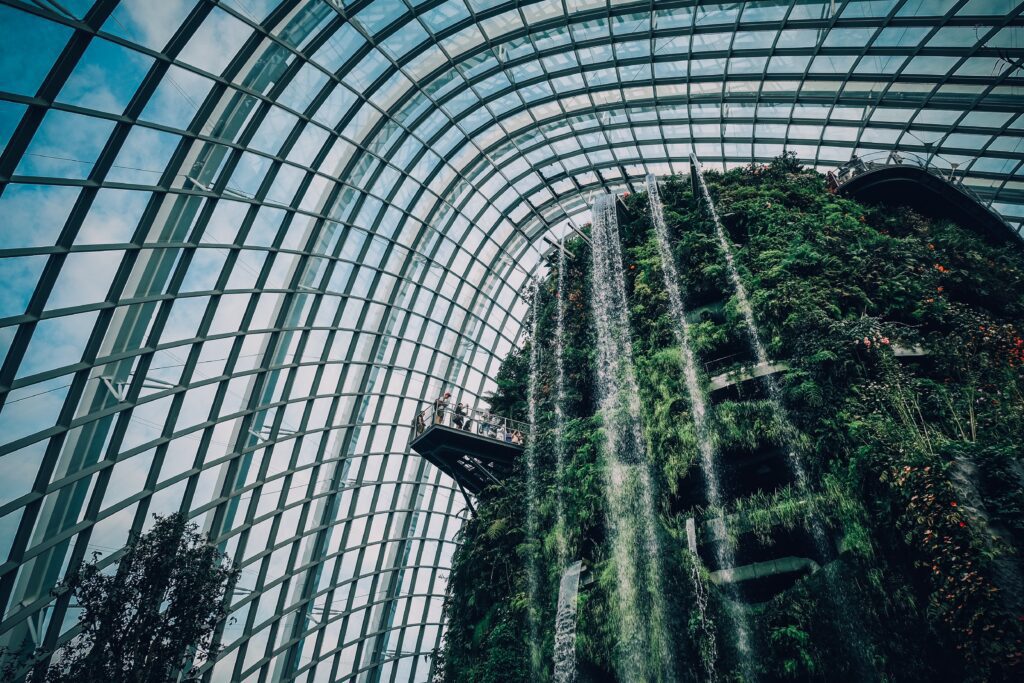
2.3 Cloud Forest
The Cloud Forest will undoubtedly mesmerize you. As soon as you enter the mist-filled conservatory, you’ll be transported to a mystical world of lush vegetation and cascading waterfalls. The highlight being a towering mountain covered in a shroud of mist, which creates an ethereal atmosphere. As you make your way up the mountain, you’ll encounter a diverse collection of plants, including rare and exotic species from tropical highlands.
Cost: 18 SGD, 28 SGD for both Cloud Forest and Flower Dome
3. Marina Bay Sands
Just getting all the classic landmarks out of the way, the next one on the list is of course Marina Bay Sands. This impressive hotel, casino, and entertainment complex is located in the Marina Bay area and is easily recognizable by its unique design featuring three towering hotel towers connected by a massive rooftop park.
One of the top attractions at Marina Bay Sands is the SkyPark Observation Deck, head up for stunning views of the city skyline though I much prefer looking at it from afar. The Observation Deck is located on the 57th floor of the hotel and is accessible by elevator. Tickets to the Observation Deck can be purchased online or at the ticketing counter on the 1st floor of the hotel.
Cost: Free, 23 SGD for SkyPark Observation Deck
4. Sentosa Island
Sentosa Island is a small island off the southern coast of Singapore that has a rich history dating back to the 19th century. Originally known as Pulau Blakang Mati (which means “Island of Death from Behind” in Malay), it was used by the British as a military fortress to defend the port of Singapore. The island was later renamed Sentosa, which means “peace and tranquility” in Malay, in 1972 as part of a government effort to transform it into a resort destination. Sentosa Island is pretty much where the magic happens in Singapore. It’s a very family-friendly place with plenty of attractions in every corner to entertain children and young-at-heart alike!
4.1 Universal Studios Singapore
Located in Sentosa Island, the only Universal Studios theme park in Southeast Asia, and offers a diverse range of attractions, rides, and entertainment for visitors of all ages.
The park is divided into seven themed zones, each inspired by popular movies or TV shows such as Transformers, Jurassic Park, and Shrek. You can get the tickets for Universal Studios through here.
Cost: 81 SGD
4.2 Palawan Beach
Palawan Beach, another popular sight on Sentosa Island, is known for its crystal-clear waters and white sand. You can spend hours lounging on the beach and soaking up the sun, or you can take a dip in the water and cool off. There are also plenty of activities to keep you entertained, such as kayaking, paddleboarding, and even beach volleyball.
One of the main attractions of Palawan Beach is the Southernmost Point of Continental Asia, which is a short walk away.
Cost: Free
4.3 Fort Siloso
Built in the late 19th century, Fort Siloso was once a defensive military outpost, designed to protect the island from naval attacks. Today, it has been transformed into a museum and provides a fascinating peek into Singapore’s military history. You can explore the underground tunnels, machine gun posts, and other fortifications that once played a key role in Singapore’s defense strategy while looking for the twelve batteries scattered around.
Cost: Free

5. Chinatown
If you want to really immerse yourself in Singaporean culture, then head to Chinatown! Located in the heart of the city, Singapore’s Chinatown is home to a diverse array of shops, restaurants, temples, and traditional markets, all of which are a feast for the senses. One of the places I really recommend to visit is the Chinatown Heritage Centre as it offers a glimpse into the daily lives of Singapore’s early Chinese immigrants. You can explore the recreated scenes of a traditional kitchen, bedroom, and living room, and learn about the challenges and triumphs of the early Chinese settlers. Of course, the bustling food scene around Chinatown is top-notch and your tummy won’t have any complaints after you’re done here!
Don’t miss the Buddha Tooth Relic Temple, one of the largest and intricate Buddhist temple in the city. The temple’s main highlight is the relic chamber, which houses as you may have guessed, the tooth relic of the Buddha. Aside from the relic, there’s also a museum and rooftop garden.
Cost: Chinatown is free, the Chinatown Heritage Center costs around 18 SGD while the Buddha Tooth Relic Temple is also free
6. Little India
On the other side of Chinatown there’s Little India! Little India is one of the most vibrant and colorful districts in Singapore, known for its lively atmosphere and rich cultural heritage. It’s a great place if you who want to experience authentic Indian culture in Singapore. From colorful traditional clothing, fragrant spices in bustling markets, to beautiful temples and delicious Indian cuisine, it’s a feast to the senses!
One of the most famous landmarks in Little India is the Sri Veeramakaliamman Temple, which is dedicated to the Hindu goddess Kali. The temple features colorful, intricate sculptures and carvings depicting Hindu deities and mythical creatures.
Cost: Free

7. Kampong Glam
You might be seeing a pattern here but the next neighborhood that I really recommend to visit would be Kampong Glam. This historic neighborhood also carries with it a rich cultural heritage traced from the Malay and Arab communities. An excellent way to understand what makes Singapore unique is to visit these places as they truly carry the essence of what makes Singapore…well, Singapore!
At the heart of Kampong Glam is the Sultan Mosque, a beautiful example of traditional Islamic architecture that dates back to 1928. The streets around the mosque are filled with colorful shophouses and boutiques selling everything from traditional Malay textiles to Middle Eastern spices and handmade crafts.
There are also plenty of cafes and restaurants serving up delicious Malay and Arab cuisine, as well as trendy bars and music venues that attract a hip and youthful crowd. Make sure to drop by Haji Lane, a narrow alleyway lined with colorful murals and quirky boutiques.
It’s a great place to simply grab a coffee and people-watch. The Malay Heritage Centre is another place that offers a fascinating glimpse into Malay history and culture.
Cost: Free
8. Pulau Ubin
Pulau Ubin is a hidden gem for those who want to escape the hustle and bustle of the city. Located just off the northeast coast of Singapore and easily reachable via a 10-minute boat ride from Changi Port Ferry, transport yourself to a rustic island to get in touch with nature. A perfect get-away for any nature enthusiast with plenty of forests, mangrove swamps and beaches to frolic in! Pulau Ubin is also home to traditional kampung (village) houses for those wanting to get an idea on what life was like back then.
Cost: 3 SGD for one way boat ride
9. Haw Par Villa
Looking for something totally unique and a little bit weird in Singapore? Check out Haw Par Villa. Trust me, it’s not your typical theme park. A cultural hidden gem, this place is packed full with over a thousand statues and dioramas, all steeped in Chinese folklore and mythology. Now, brace yourself, because you’ll come across some pretty wild scenes like the Ten Courts of Hell, which give a graphic (and slightly horrifying) depiction of the punishments meted out in the afterlife. But don’t let that scare you off! It’s all part of the charm. Haw Par Villa is a vibrant, colorful mishmash of the strange and the beautiful that’ll leave you with plenty of stories to tell. And it’s a must-visit spot if you’re looking to delve into a different side of Singapore’s rich cultural heritage.
Cost: Free
Top Things to Do in Singapore
10. Cruise Along Singapore River
Go on scenic journey with a new perspective by riding a bumboat around the Singapore River! As you float along the river, you’ll be surrounded by stunning views of the city’s iconic skyline, passing by some of Singapore’s most famous landmarks.
The Singapore River was once the lifeline of the city, serving as a major port for trading ships in the early days. Today, it’s been transformed into a picturesque waterway lined with historic shophouses, stylish restaurants, and trendy bars.
You can book an affordable river cruise with my partner at GetYourGuide.
11. Try out Hawker Food
When it comes to food in Singapore, the hawker centres are simply a must. These open-air food courts offer a wide variety of delicious and affordable dishes that are sure to satisfy any palate. Not only is the food delicious, but the hawker centres themselves are a cultural experience. You’ll get a glimpse into Singapore’s diverse population and see people from all walks of life enjoying a meal together.
Some of the most popular ones include Maxwell Food Centre, Tiong Bahru Market, and Old Airport Road Food Centre. Each centre has its own unique atmosphere and specialties, so be sure to try out a few to get the full hawker experience.
Some must-try dishes include Hainanese chicken rice, laksa, char kway teow, and satay. And don’t forget to wash it all down with a refreshing glass of sugarcane juice or a local favorite, teh tarik (pulled tea).
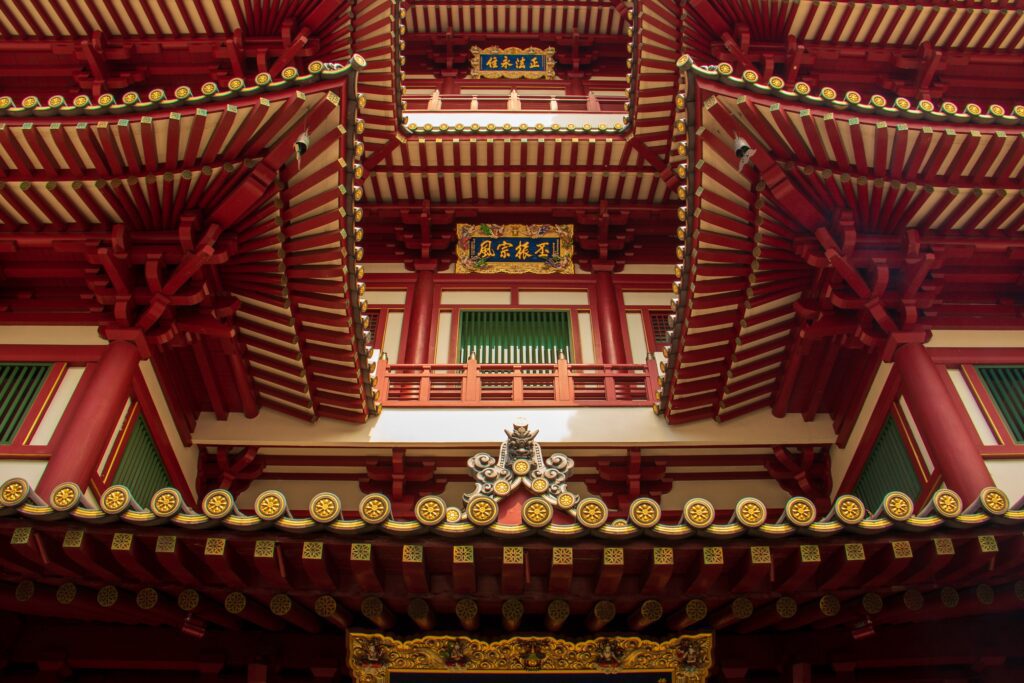
12. Go Temple-Hopping
Experience another side of Singapore by visiting the various temples scattered around the city. Most of the temples are actually near each other and I was able to visit a majority of them simply by walking around Chinatown. From Buddhist, Christian, Islamic, Hindu, and Taoist temples, it’s an amazing way to immerse yourself in complete religious diversity and harmony. Some of the most notable temples to visit include the Buddha Tooth Relic Temple and Sri Mariamman Temple in Chinatown, the Thian Hock Keng Temple in the Central Business District, and the Masjid Sultan in Kampong Glam. If you want to learn about the best temples to check out in Singapore, check out this blog post.
13. Join a Heritage Tour
Joining a heritage tour is an excellent way to learn more about the Singapore’s history and traditions. There are several guided tours available that take you through the various cultural districts of Singapore, including Chinatown, Little India, and Kampong Glam.
During these tours, you can explore the architecture, food, and customs of each district, gaining a deeper understanding of Singapore’s multiculturalism. Some tours also offer hands-on experiences, such as learning how to make traditional Peranakan kueh or batik fabric.
14. Experience Traditional Medicine
Traditional Chinese medicine is an important aspect of Singaporean culture and remains to be an integral part of its society to this day. You can find plenty of traditional medicine shops and practitioners in Chinatown. Try out acupuncture, cupping therapy or browse shops for herbal remedies and teas. It’s all quite holistic actually and who knows you might be able to gain some new insights on your health!
15. Visit a Rooftop Farm
Amidst the concrete jungle of Singapore, there are pockets of green spaces popping up in the most unexpected places – on the rooftops of towering skyscrapers! One such place is the rooftop farms, where urban farming has taken off in a big way.
Drop by to experience sustainable agriculture practices in action and learn about how crops are grown and harvested using innovative methods. These rooftop farms not only produce fresh fruits and vegetables but also contribute to environmental sustainability by reducing carbon emissions, conserving water and creating habitats for biodiversity.
Some popular rooftop farms to visit in Singapore include the ComCrop, located on the rooftop of a multi-story car park in the heart of the city, and the Sky Greens, which uses a rotating system to maximize space and sunlight.
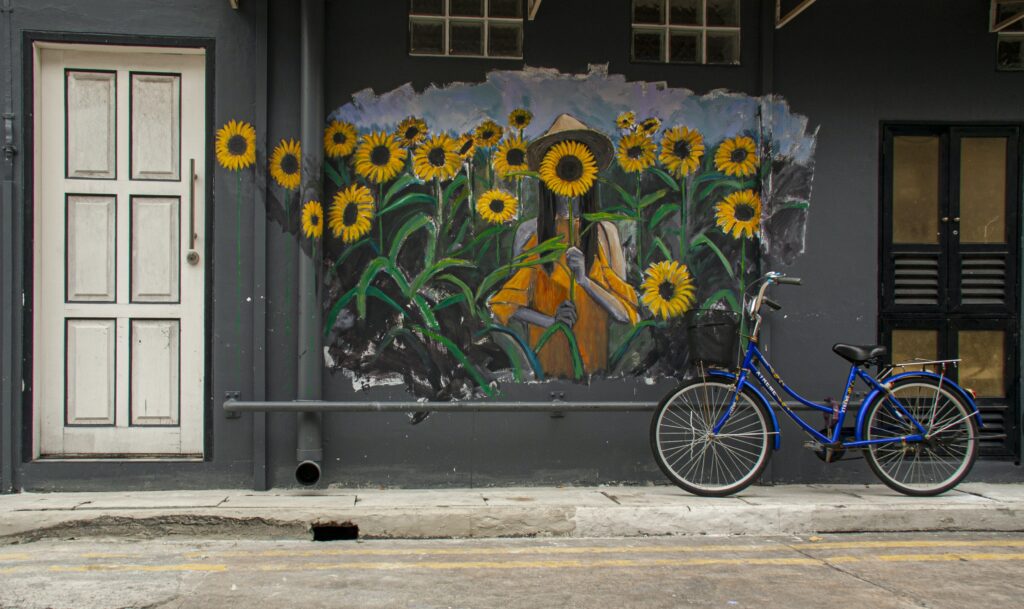
16. Spot some Street Art
While Singapore is known for its sleek and modern architecture, the city also boasts an array of colorful street art. Head to neighborhoods like Tiong Bahru, Haji Lane, and Kampong Glam to explore some of the best street art in the city. Finding street art is half the fun so I won’t spoil anything here!
17. Explore Nature Reserves
While Singapore is often associated with urban cityscapes, it is also home to a number of beautiful nature reserves. Make your way to these places for a peaceful respite from the city life. Provide a chance to get up close with the local flora and fauna.
One of the most popular nature reserves is the Bukit Timah Nature Reserve, which is home to a variety of hiking trails and the highest “mountain” in Singapore, Bukit Timah Hill, at a whopping 164 m (538 ft). Jokes aside, the reserve also boasts over 840 species of flowering plants and over 500 species of animals, including monkeys, squirrels, and various bird species.
Where to Stay in Singapore
Singapore is one of those Southeast Asian countries that tend to be on the pricier side. Though in exchange, what you can find can be a bit more upscaled as well. I recommend these hotels & hostels:
Best Hotels in Singapore
- Vibe Hotel Singapore Orchard – offers a relaxing atmosphere with modern decor and is ideal if you want to connect with fellow travelers or work while enjoying the local area. The hotel also provides free Wi-Fi. The rooms are tastefully designed, and amenities include cable TV, a tea/coffee maker, and a private bathroom with shower facilities and a hairdryer. The hotel also has disabled-friendly rooms available.
- lyf Farrer Park – offers sustainable accommodations just a 4-minute walk from Mustafa Centre. The air-conditioned rooms come with a private bathroom and free Wi-Fi, and the hotel features a fitness center, a 24-hour front desk, and a shared kitchen.
- Village Hotel Sentosa – a 4-star hotel, conveniently situated near popular attractions such as Wings Of Time, Adventure Cove Waterpark, and S.E.A. Aquarium. The air-conditioned rooms come with free Wi-Fi and a private bathroom, and the hotel also features a fitness center, 24-hour front desk, and room service. Each room is equipped with a kettle and a flat-screen TV with satellite channels.
Best Hostels in Singapore
- CapsulePod@Aljunied – this is where my friend and I stayed. I can safely say it exceeded my expectations. It has a very chic and modern look, really high-tech capsules and curtains are always a big bonus for me. Really young crowd, the rooms were also very quiet. All in all, I would say this is really the best hostel in Singapore with really affordable rates.
- 7 Wonders Hostel @ Boat Quay – within walking distance of popular attractions such as Singapore City Gallery and Sri Mariamman Temple. The property features a shared kitchen and luggage storage, and free Wi-Fi is available throughout. Rooms come with a shared bathroom with a bidet, and some rooms have a kitchen.
- Galaxy Pods Capsule Hotel – offers air-conditioned rooms, a shared lounge, free Wi-Fi, and a terrace. The hostel features a 24-hour front desk and luggage storage. Each room includes a desk, a flat-screen TV, and a shared bathroom with bed linen and towels provided. A microwave is also available for you to use.
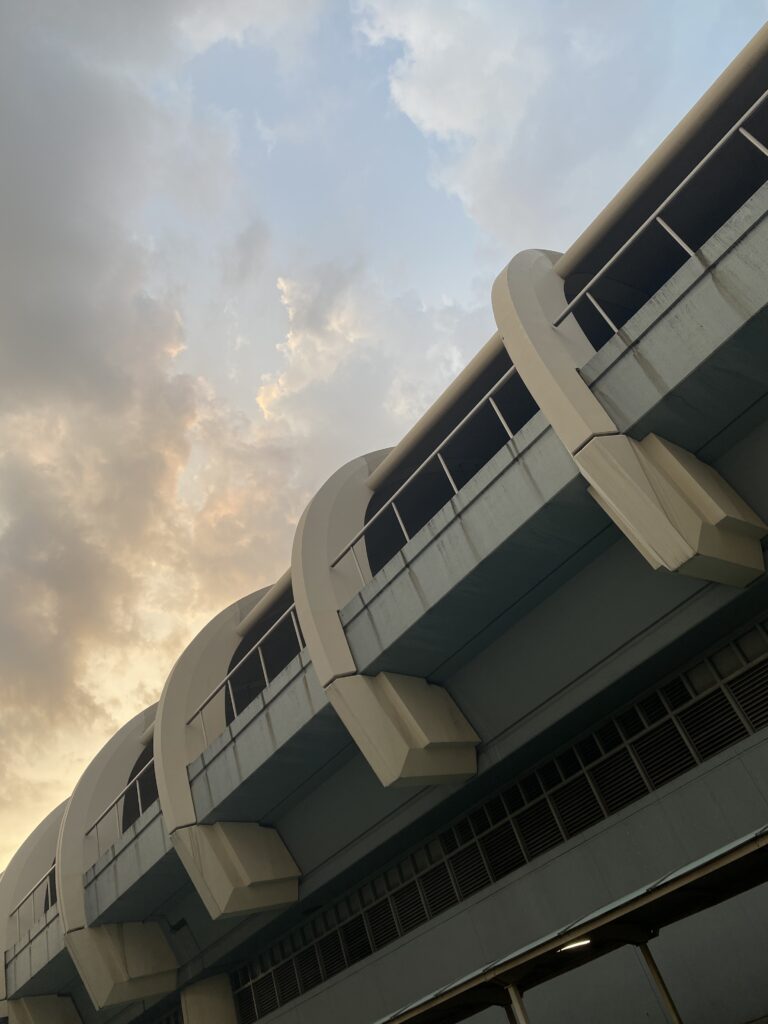

How to Get Around Singapore
Walking: Singapore is a relatively small country, and once you’re in the city a lot of areas are easily accessible by foot.
Mass Rapid Transit (MRT): Singapore boasts a fast, efficient, and affordable subway system. It operates from 5:30 am to midnight daily and covers most areas of the island. I was even just able to tap my credit card as is though you can buy the metro card as well.
Bus: The bus system in Singapore is extensive and reliable. You can pay with cash, transit cards or with your credit card.
Taxi: Taxis are readily available in Singapore, and they are metered. You can hail one on the street or book a ride through popular ride-hailing apps such as Grab and Gojek.
Bicycle: Singapore has a growing network of cycling paths, and you can rent a bike from various locations across the island.
One of the best travel booking resource for Singapore and Southeast Asia is 12Go, whether it’s land, sea or air transportation, try them out if you need further assistance from getting from point A to point B.
How to Stay Safe in Singapore
Singapore is a very safe country day or night. Just use common sense and keep your wits about you at night or when partying but aside from that, feel free to enjoy the city in peace knowing that you’re in a country with one of the lowest crime rates and is ranked as one of the top 10 safest countries in the world.
That being said, it’s better to be safe than sorry. Even for countries like Singapore, I still recommend getting travel insurance from a reputable provider like SafetyWing.
Best Time to Visit Singapore
The best time to visit Singapore is from February to April, during the dry season, when the weather is pleasant with less rainfall. Singapore has a tropical rainforest climate, with consistent temperatures throughout the year ranging from 23°C to 31°C (73°F – 88°F) during the day, and 22°C to 26°C (72°F – 79°F) during the night.
The months of June to September see more rainfall, with occasional thunderstorms and heavy downpours. The average temperatures still remains more or less the same. However, the humidity levels do rise during this period, which can make it feel warmer. This is also the Southwest Monsoon season, which brings with it more frequent showers and occasional thunderstorms, usually occurring in the afternoon and early evening. Despite the rain, many find this a wonderful time to visit due to the cooling effect of the rain showers and the lush greenery that follows.

What to Pack For Singapore
Power adapter: Singapore uses a type G power outlet, so if you’re coming from a country with a different type of outlet, be sure to pack a power adapter
Lightweight and breathable clothing: T-shirts, shorts, skirts, and dresses made of natural fibers such as cotton or linen will keep you cool and comfortable
Sunscreen: The sun can be strong in Singapore, so it’s important to pack sunscreen with at least SPF 30
Umbrella or rain jacket: Singapore experiences occasional rain showers throughout the year, so it’s a good idea to pack an umbrella or rain jacket
Comfortable walking shoes: With plenty of walking and exploring to do, comfortable shoes are a must
Insect repellent: Mosquitoes are particularly around in the evenings, so it’s a good idea to pack insect repellent
Plan Your Trip to Singapore | Best Travel Resources
Book Your Accommodations
- Booking.com – the world’s leading online booking platform for accomodations around the world, they have an extensive amount of available listings with zero booking fees and best price guarantees.
- Hostelworld – a backpacker’s best friend, Hostelworld has the largest collection of hostels and guesthouses for affordable prices.
Don’t Forget Insurance
- SafetyWing – from Nomad Insurance, an insurance by nomads for nomads. They understand our lifestyle well and have really comprehensive and flexible plans that cater to any traveler.
Find Cheap Flights
- Kiwi.com – my go-to for booking and finding the cheapest flights and it’s helped me save tons of money. They do virtual interlining which is connecting flights from airlines that do not codeshare, so you can find routes that you wouldn’t be able to find normally.
Join Tours & Activities
- GetYourGuide – is one of the best places to find unique tours and activities. I found that it’s an excellent way to meet fellow travelers and create fond memories. They are not only limited to tours as they also offer niche services such as skip-the-line tickets or private transfers.
Catch a Ride
- Rentalcars.com – nothing beats the freedom of the road, Rentalcars.com is the world’s largest online car rental service. They operate across 160 countries so they’re the perfect partner to work with if you find yourself wanting a ride.


